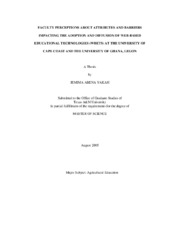| dc.description.abstract | The purpose of this study was to determine faculty perceptions about factors
impacting the adoption and diffusion of Web-Based Educational Technologies (WBETs)
at the University of Cape Coast and the University of Ghana, Legon. This study, based on
Rogers’ theory of adoption and diffusion, is a modified replication of a study by Li
(2004), in the context of Ghana. Data were collected with a modified instrument created
by Li (2004), from 61 teaching faculty out of a target accessible population of 200. The
instrument comprised of four sections: The first, was used to collect data about faculty
stage in the innovation development process. The second was used to collect data
describing five attributes (relative advantage, compatibility, complexity, trialability, and
observability) impacting the adoption and diffusion of WBETs. The third was used to
collect data about ten barriers (concerns about time, concerns about incentives, program
credibility, financial concerns, planning issues, conflict with traditional education, fear of
technology, technical expertise, administrative support, and infrastructure) impacting the
adoption and diffusion of WBETs. The fourth section was used to collect data on
personal characteristics of the faculty. Descriptive, correlational and regression analyses were used to examine relationships between faculty personal characteristics, stage in the
innovation-decision process, and perceptions of attributes and barriers impacting the
adoption and diffusion of WBETs.
From the descriptive results, respondents perceived ‘relative advantage’ and
‘observability’ as the two most important attributes that impact the adoption and diffusion
of WBETs. Infrastructure, financial concerns, and technical expertise were perceived as
posing moderate to strong barriers to the adoption and diffusion of WBETs. Only
compatibility (attribute) and technical expertise (barrier) had statistically significant
correlations with faculty stage in the innovation decision process. The attributes and
barriers altogether explained only 10.6% and 17.3% respectively of faculty stage in the
innovation-decision process. Of the eight personal characteristics examined, only
‘experience with WBETs’ had a statistically significant correlation with faculty stage in
the innovation-decision process. Recommendations to administrators and policy makers
include allocating investments and resources that promote attributes and eliminate
barriers, and conduct further research into factors that affect the adoption and diffusion of
WBETs. | en |


